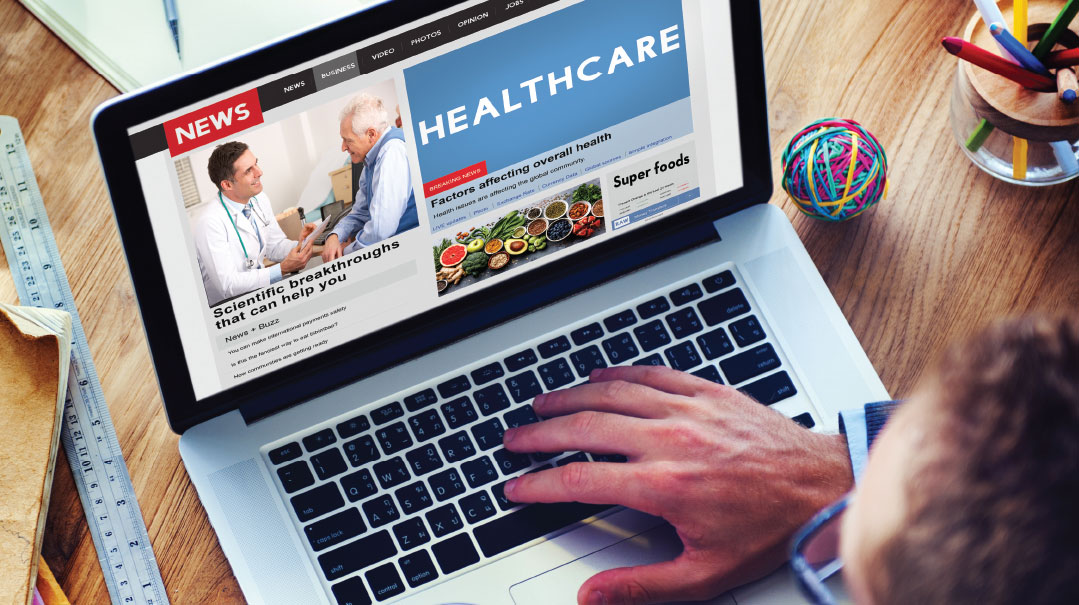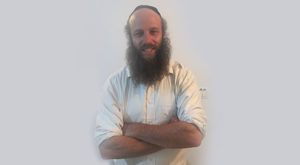A WEB OF MISINFORMATION

You already know not to believe everything you read. But when it comes to your health, can you believe anything you read?

Years ago, I watched in horror as a friend cracked an egg into a glass, then chucked the yolk into the trash.
“How could you do that?” I admonished. “Bal tashchis!”
She smiled and explained patiently that since everyone knows that yolks are bad for us, it’s not considered bal tashchis to dispose of them.
I wonder if she still believes that. I certainly don’t. Actually, I have no idea what to believe, and most likely, neither do you, considering the amount of conflicting information published.
Revisiting that long-ago exchange, I recently Googled, “Are eggs good for you?”
Here’s what I found:
Article one: “Eggs are a source of saturated fat, and too much saturated fat has been shown to raise total cholesterol and LDL (bad) cholesterol levels, risk factors for cardiovascular disease.”
Article two: “Eating eggs leads to elevated levels of high-density lipoprotein (HDL), also known as the ‘good’ cholesterol. People who have higher HDL levels have a lower risk of heart disease, stroke, and other health issues.”
Both studies were reputable, so how could they lead to such contrasting conclusions? Well, according to an article on the Harvard Health Publishing website, it’s hard to test for food benefits because “human diets are complex and notoriously hard to study.” But where does that leave me — and my omelet?
Mental Whiplash
One day coffee improves your concentration and lowers your risk of diabetes, the next it’s carcinogenic. Depending on what you choose to read, nuts are full of health benefits, or they’re full of dangerous fat. And what’s the deal with coconut oil? I remember learning that it was one of the worst fats to ingest, then woke up one day to find out that it was the only oil I should be using.
It’s enough to make me wonder if there’s any food that’s definitely good for me.
Dr. Jonathan Schoenfeld from the Stanford Prevention Research Center and Dr. John Ioannidis from Harvard Medical School pondered a similar question in 2012. They investigated 50 common ingredients, which they chose at random from recipes in the Boston Cooking-School Cookbook, to find out which ones had been linked to cancer risk in recent studies. Their report — titled “Is Everything We Eat Associated with Cancer?” — was published in the American Journal of Clinical Nutrition, along with their findings: “Forty ingredients (80%) had articles reporting on their cancer risk.” This list included salt, sugar, flour, eggs, onions, celery, carrots, milk, cheese, and tea — basic stuff you likely ingest every day.
“One wonders whether this highly charged atmosphere and intensive testing of food-related associations may create a plethora of false-positive findings and questionable research practices,” the authors wrote in their introduction. In the course of their research, they found that the associations between these foods and cancer were weak and often false in comparison to larger study findings.
Their study was not cause for panic. Instead, it showed just how much improvement is needed in nutritional research and how wary one should be when trying to base food decisions off a single report or headline.
Billions of dollars are spent yearly as researchers try to figure out what we should and shouldn’t be eating to minimize our risk for chronic disease and maximize our health benefits. Every month, new studies about food are published. In truth, not one of them is perfect. And food is only the tip of the iceberg when it comes to reading about your health.
Misled by Medical News
Lewis Blackman was a star student and an avid soccer player at his high school in Columbia, South Carolina. But the 15-year-old also had a congenital condition known as pectus excavatum, which causes a concave appearance of the chest. When his parents read in the local paper of a new procedure to correct the defect that was “safer and quicker” than the alternative — an hours-long surgery that involved opening the chest cavity — they were intrigued.
In the article, Dr. Andre Hebra, a pediatric surgeon at the Medical University of South Carolina (MUSC), claimed that the surgery took only an hour and was followed by a relatively quick recovery. Lewis and his parents discussed the idea with their own doctor as well as others at MUSC and decided to go ahead with it.
“We did our homework,” says Helen Haskell, Lewis’s mother. “We thought it was a good idea. This seemed like a safe, minimally invasive procedure that could help our son. We thought it was like getting braces.”
In addition to speaking with doctors, Helen and her husband read up on the procedure, which involved making small incisions and inserting a metal bar to prop up the chest. They saw no mention of what they later found out was a fairly high complication rate.
The procedure was supposed to take under an hour. Instead, it took over two.
Two days after the surgery, Lewis came down with a fever.
The following morning, he awoke with intense abdominal pain.
Thirty-one hours after that pain began, Lewis died. The cause, they learned too late, was a perforated ulcer that resulted from post-surgery pain medication.
“The risks of that procedure were absolutely minimized, to the point of being misleading,” says Helen, who later founded Mothers Against Medical Error, a patient advocacy organization, and successfully advocated for patient-rights legislation in the state of South Carolina.
Lewis died in 2000. In 2002, an article was published in the Journal of Pediatric Surgery claiming that there were no deaths from the procedure Lewis had undergone. Helen wrote an unheeded letter to the editor of the Journal of Pediatric Surgery in response to the false claim.
“Medical research can be incorrect or misleading for a variety of reasons,” Helen says. “Science is not always obvious or straightforward — and neither is research design. There’s no such thing as a perfect study. When people have a specific end in mind, they may consciously or unconsciously create a trial that is more likely to achieve results that reflect their beliefs.”
To illustrate her point, she mentions recent findings on a procedure called cardiac ablation, which scars heart tissue to terminate faulty electrical pathways. Developed in the early 2000s, cardiac ablation is now considered a fairly standard procedure among cardiologists and, according to the American Heart Association website, there are “few risks” associated with the procedure and “problems are rare.” A 2009 report in the Journal of the American College of Cardiology reported a mortality rate of 1:1000.
But according to Helen, patient advocates like herself were seeing a number of serious complications associated with this procedure. She wasn’t surprised when, in October 2019, a survey of “real world data” from a national database reported the number of deaths within days of the procedure to be almost one in 200, nearly five times more than the previous study.
“Doctors are not malicious,” says Helen. “If medical literature is not giving them information, they will simply not know about it. Their experiences are limited to what they’ve seen themselves. Even if they do experience complications, they’ll think it’s unusual because they’re not seeing it in the literature.”
Why Do Headlines Change So Rapidly?
That’s a fair question, but before we address it, let’s explore the challenges of obtaining reliable data. “It’s the result of years of research conducted by multiple researchers,” says Dr. Netanel Schwob, a pediatrician in Baltimore, Maryland. Once there are enough reputable, long-ranging studies, the medical community can begin to rely on the substantiated conclusions.
“For example,” says Dr. Schwob, “babies used to be put to sleep on their backs until it was observed that there was a 30 percent decrease in SIDS when they slept on their stomachs.”
Feeding peanut butter to children under the age of two is another example of how medical advice has evolved over the years. “In Israel, everyone eats peanut butter from a very young age,” Dr. Schwob says. “Here in America we were taught not to do that until age two. But under the new criteria, it is advisable to introduce peanuts early in life.”
The common factor in these new conclusions is that they’re not based on isolated studies. The scientific conclusions were formed cumulatively, after repeated tests and a fair amount of time.
Relying on a single study is like buying a newfangled product that’s still in the testing stage — the kinks haven’t been worked out yet. Indeed, early medical research and isolated studies are not meant for public dissemination. But because the media is eager for flashy headlines, results are often published too early.
When a single test is done with exciting results, it’s published. Then a second test is done a short time later with different results, and that’s published as well. That’s why medical advice seems to flip-flop so rapidly.
There’s plenty of room for error even when studies are cumulative. Much of our knowledge about nutritional benefits, for example, is gleaned from observational studies. The problem is that there are so many variables — such as daily intake and illness — that it’s not possible to establish a uniform group of study subjects.
This makes it difficult to determine, say, whether a Mediterranean diet caused longevity or if it was the higher income bracket and more leisurely lifestyle of those who followed it that contributed to a long life. Study participants whose habits are questioned in order to draw conclusions may be less than accurate with the details they offer, and to make things even more confusing, people metabolize and react to foods differently.
And then there is the placebo effect. When people are given a supplement or pill, they often believe that they’ve been “cured” when they’ve been given nothing to create that result.
Research funded by companies with vested interest — such as pharmaceuticals or food industry giants — is likely to be questionable. “Findings can be motivated by money,” says Dr. Schwob. That doesn’t mean that results are deliberately skewed. But what it can mean is that the study is designed in a way that can influence the outcome.
“There is also the human factor,” adds Helen. “When you put your life into writing or developing something, you want it to work. People become attached to their work.”
Finding the Truth
“Chocolate Prevents Wrinkles!”
That’s ripped off an actual headline, and it’s easy to see why sensational news like this can make people excited. Here’s an excerpt from that article: “…A new study suggests cacao could… significantly reduce wrinkles on the skin caused by exposure to the sun. Scientists from Seoul National University in Korea tested cacao powder on hairless mice over eight weeks and found a significant reduction in wrinkles on their skin caused by exposure to the sun.”
This would be great news if the test was conducted on humans. The more you have in common with study subjects, the more likely it is that the study’s findings will have a similar effect on you. That’s a good rule to remember when reading “news” like this. Another key factor here is time. This sort of study suggests the possibility of skin benefits, but it would take a longer period of observation on humans in a controlled group for that news headline to make a real difference in your life.
It’s easy to see why this study’s results aren’t earth-shattering. But what about research that seems to have life-altering results?
Start by looking at the study to determine just how many people participated, the quality of the institution at which it was conducted, and whether the results were replicated in other studies. The larger the study, the more reputable the institution, and the more corroborated results, the more likely it is that the research is accurate.
It’s important to know who conducted the research. In addition to checking out their credentials and reputation, pay attention to their field of expertise. Take the popular low-carb, high-fat ketogenic diet, promoted by many trainers and nutritionists as beneficial to the brain and an easy way to lose weight. However, someone involved in metabolic research can tell you that the ketogenic diet was created to treat certain diseases and isn’t recommended for people without medical conditions.
You’ll also want to check who funded the study. If the study on chocolate and wrinkles was funded by a chocolate company, it would be easy to see why there could be vested interest in positive findings.
And don’t forget to ask one more important question: “Where was this published?” Dr. Schwob asks. “Was it in a reputable medical journal? Do your homework. Look up the publications. Make sure the authors and owners of the site are reputable.”
The New England Journal of Medicine in the United States and the Lancet in the UK are among the world’s most reputable peer-reviewed medical journals. Also highly regarded is JAMA, the Journal of the American Medical Association, which has separate journals for each medical specialty.
No matter how reputable the publication, you still have to gather as many details as possible about the study itself. Websites recommended by Dr. Schwob as good resources of information are the American Academy of Pediatrics, NIH, and Mayo Clinic sites.
Dr. Schwob uses an online resource called UpToDate, which helps physicians stay current with reliable, research-based information. “There’s a section called ‘What’s New’ that’s divided by specialty and helps me stay on top of the latest developments,” Dr. Schwob says. UpToDate is not only available to physicians — it’s possible for anyone to sign up online for a small fee to gain access to the very same information physicians use.
The very best resource for accurate information is your own doctor. “Make sure the physician you go to is well-trained,” says Dr. Schwob, “and seek out subspecialists for complex issues. Organizations such as ECHO or ROFEH can help guide you to the best professional. Ask your doctor, ‘What would you do for yourself in this situation?’ ”
If a patient approaches Dr. Schwob about a new development, his first step is to examine the patient’s history. “Say you’re asking me whether eggs are good or bad for you based on what you’ve just read. The first thing I’ll do is look at your history of heart attacks and clogged arteries. Today, we screen for high cholesterol at young ages. If there are warning signs in that direction, I’ll limit the yolk intake even if the latest headlines indicate that there are other nutrients in there.”
Dr. Schwob is cautious about what he reads. “If something new has been introduced on the market, I might wait a while before recommending it,” he says. “I consider strongly the risk versus benefit in any case. As you get more experienced, you’re more equipped to make that call.”
Patient advocacy groups can be an invaluable resource to exchange real information and share experiences, according to Helen. These can be found on social media, and some of these groups have been so powerful that they’ve helped change faulty medical practices.
But even with a strong combination of solid research and advice from a trustworthy and adequately trained medical professional, questions linger.
“Hashem hides things from us,” says Dr. Schwob. “We don’t have any way of knowing everything, and what we think we know changes all the time. Will they conclude one day that vitamin D is not good? Maybe. You can be stuck in a perpetual state of questioning all the time, or you can do your best with the knowledge we do have.”
So, will I be eating that three-egg omelet? Maybe. But I definitely won’t be tossing those yolks. There’s bound to be a report somewhere letting me know how they’ll transform my health.
Fake News?
Always maintain a healthy dose of skepticism before you get excited over something you read — even if it involves the benefits of chocolate. Here are some warning signs of unreliable medical research:
Sudden breakthroughs. Real advancements in medical knowledge don’t happen overnight. They take time. And if something sounds too good to be true, it probably is.
Test-tube and animal studies. These may be interesting to read about, but they probably won’t have much to do with you. Tests on humans who are similar to you in age, gender, health, and lifestyle will be far more relevant.
Sponsored studies. The key factor is who sponsored the study. Was it done by the very same company that is trying to market the product that’s being tested? That would be a warning sign.
Dubious publishers. Where was the study published? If the publisher seems dubious, the “news” will likely be dubious as well. Check to see if the journal has been peer-reviewed. This means that other experts in the same field reviewed the information before it was published.
Single studies. What you’re looking for here is replicated results. An isolated test may be flawed, as many tests are. You need repeated findings to draw an accurate conclusion.
(Originally featured in Family First, Issue 705)
Oops! We could not locate your form.











